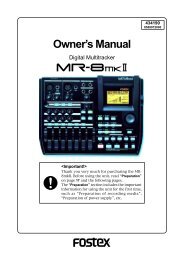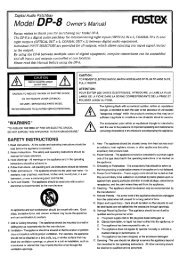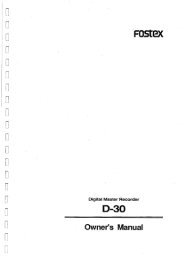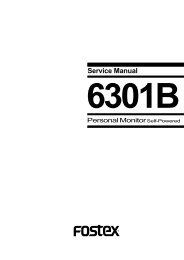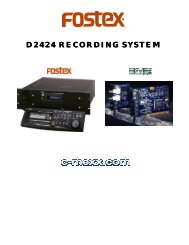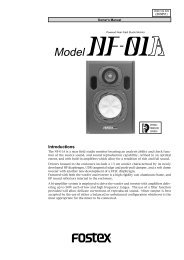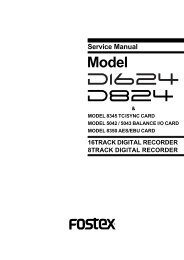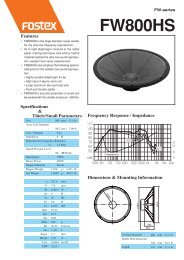audio file in the INSERT mode - Fostex
audio file in the INSERT mode - Fostex
audio file in the INSERT mode - Fostex
Create successful ePaper yourself
Turn your PDF publications into a flip-book with our unique Google optimized e-Paper software.
• Creat<strong>in</strong>g a new <strong>file</strong> on a disk just after formatted <strong>in</strong> <strong>the</strong> Tape <strong>mode</strong><br />
You can create more than one "Normal <strong>mode</strong>" <strong>audio</strong> <strong>file</strong> (of <strong>the</strong> "BWF" or "SDII" format) on a<br />
disk formatted <strong>in</strong> <strong>the</strong> Tape <strong>mode</strong>.<br />
In <strong>the</strong> follow<strong>in</strong>g procedure, we assume that a disk just after formatted <strong>in</strong> <strong>the</strong> Tape <strong>mode</strong> is<br />
loaded and a "Tape <strong>mode</strong>" <strong>audio</strong> <strong>file</strong> of <strong>the</strong> "BWF" format is selected.<br />
<br />
"Normal <strong>mode</strong>" <strong>audio</strong> <strong>file</strong>s are created <strong>in</strong> <strong>the</strong> rema<strong>in</strong><strong>in</strong>g area of a disk after two "Tape <strong>mode</strong>" <strong>audio</strong> <strong>file</strong>s<br />
(occupy<strong>in</strong>g approximately 2 GB per each <strong>file</strong>) are created when <strong>the</strong> disk is formatted <strong>in</strong> <strong>the</strong> Tape <strong>mode</strong>.<br />
Therefore, approximately 0.5 GB space can be used by "Normal <strong>mode</strong>" <strong>audio</strong> <strong>file</strong>s.<br />
1. Select a desired <strong>audio</strong> <strong>file</strong> format between "BWF" and "SDII" us<strong>in</strong>g <strong>the</strong> [AUDIO FILE] switch.<br />
2. Select a desired track <strong>mode</strong> us<strong>in</strong>g <strong>the</strong> [TR MODE] switch.<br />
3. Select a desired sampl<strong>in</strong>g frequency/bit length comb<strong>in</strong>ation us<strong>in</strong>g <strong>the</strong> [SAMPLING FREQ] switch.<br />
4. Press <strong>the</strong> [FILE SEL] key.<br />
"New FIle?" appears with flash<strong>in</strong>g "01" or "03", depend<strong>in</strong>g on <strong>the</strong> [AUDIO FILE] switch selection <strong>in</strong> step 1<br />
above.<br />
If you select "SDII", "01" flashes because this will be <strong>the</strong> first "SDII" <strong>file</strong> <strong>in</strong> <strong>the</strong> "sd2f" directory.<br />
If you select "BWF", "03" flashes because this will be <strong>the</strong> third "BWF" <strong>file</strong> <strong>in</strong> <strong>the</strong> "bwff" directory (two "Tape<br />
<strong>mode</strong>" BWF <strong>file</strong>s are already created).<br />
Flash<strong>in</strong>g<br />
PGM<br />
NEXT<br />
ABS<br />
H M S F<br />
PGM<br />
Flash<strong>in</strong>g<br />
5. Press <strong>the</strong> [ENTER/YES] key.<br />
A "Normal <strong>mode</strong>" <strong>audio</strong> <strong>file</strong> is created and <strong>the</strong> display shows <strong>the</strong> tentative <strong>file</strong> name, as well as <strong>the</strong> "ABS 0"<br />
time (<strong>the</strong> beg<strong>in</strong>n<strong>in</strong>g of <strong>the</strong> <strong>file</strong>). The tentative name beg<strong>in</strong>s by "S" or "B" which shows <strong>the</strong> <strong>file</strong> format ("S"<br />
for "SDII" and "B" for "BWF") selected by <strong>the</strong> [AUDIO FILE] switch <strong>in</strong> step 1 above, followed by <strong>the</strong> time and<br />
date when <strong>the</strong> <strong>file</strong> is created.<br />
A tentative name can be edited. See "Edit<strong>in</strong>g a <strong>file</strong> name" described later.<br />
If you create ano<strong>the</strong>r <strong>audio</strong> <strong>file</strong>, regardless of whe<strong>the</strong>r <strong>the</strong> currently selected <strong>audio</strong> <strong>file</strong> is "Tape <strong>mode</strong>" or<br />
"Normal <strong>mode</strong>", carry out steps 1 through 4 above and <strong>the</strong>n use <strong>the</strong> jog dial to show "New File?", followed<br />
by press<strong>in</strong>g <strong>the</strong> [ENTER/YES] key.<br />
PGM<br />
NEXT<br />
Tips:<br />
The <strong>file</strong> number of a newly created<br />
"Normal <strong>mode</strong>" <strong>audio</strong> <strong>file</strong> depends<br />
on <strong>the</strong> format of <strong>the</strong> two "Tape<br />
<strong>mode</strong>" <strong>audio</strong> <strong>file</strong>s.<br />
If you create a "Normal <strong>mode</strong>" <strong>audio</strong><br />
<strong>file</strong> of <strong>the</strong> same format as <strong>the</strong><br />
"Tape <strong>mode</strong>" <strong>audio</strong> <strong>file</strong>s, "03" is assigned<br />
to <strong>the</strong> <strong>file</strong> number.<br />
If you create a "Normal <strong>mode</strong>" <strong>audio</strong><br />
<strong>file</strong> of <strong>the</strong> different format from<br />
<strong>the</strong> "Tape <strong>mode</strong>" <strong>audio</strong> <strong>file</strong>s, "01" is<br />
assigned to <strong>the</strong> <strong>file</strong> number.<br />
bwff<br />
sd2f<br />
Tape_<strong>mode</strong>1.wav (01)<br />
Tape_<strong>mode</strong>2.wav (02)<br />
*************.wav (03)<br />
*************.wav (04)<br />
*************.wav (05)<br />
*************.sd2 (01)<br />
*************.sd2 (02)<br />
*************.sd2 (03)<br />
*************.sd2 (04)<br />
*************.sd2 (05)<br />
bwff<br />
sd2f<br />
************.wav (01)<br />
************.wav (02)<br />
************.wav (03)<br />
************.wav (04)<br />
************.wav (05)<br />
Tape_<strong>mode</strong>1.sd2 (01)<br />
Tape_<strong>mode</strong>2.sd2 (02)<br />
*************.sd2 (03)<br />
*************.sd2 (04)<br />
*************.sd2 (05)<br />
9-3



